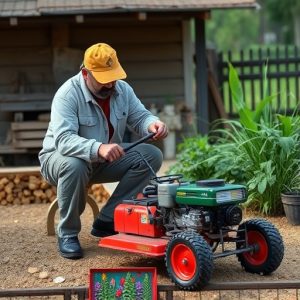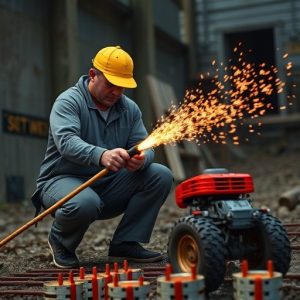Mastering Self-Defense: A Guide to Kubotan Training and Techniques
The Kubotan is a compact self-defense tool that significantly enhances defensive capabilities by ac…….
The Kubotan is a compact self-defense tool that significantly enhances defensive capabilities by acting as an extension of the hand to administer precise and controlled strikes or restrain attackers. It is a key-like device that, despite its unassuming appearance, offers sophisticated applications in martial arts training. Mastery of the Kubotan requires rigorous training that emphasizes precision and intentionality in each strike, as well as an understanding of its strategic role. Proper use of the Kubotan extends beyond physical handling; it involves a deep comprehension of its tactics in self-defense. Aspiring users should seek guidance from experienced instructors to ensure they learn correct techniques and applications safely and effectively. The Kubotan was developed by Master Frank Karszky, inspired by the teachings of Judo champion Kyuzo Mifune, and has become a staple in numerous martial arts including Aikido, Brazilian Jiu-Jitsu, and Krav Maga. It is an indispensable tool for those seeking to strengthen their self-defense skills through effective integration with hand-to-hand combat techniques. The Kubotan's versatility allows it to be used as a striking instrument, for control and restraint, and for applying pressure to key points on the body. Advanced training covers a wide range of scenarios to ensure practitioners can effectively use this tool in self-defense situations, making it an essential component for martial artists and self-defense enthusiasts who wish to enhance their skills and preparedness. How to use a Kubotan effectively is detailed in comprehensive training programs that emphasize the importance of precision, technique, and situational awareness. Regular practice with realistic drills is crucial for mastering this tool and incorporating it seamlessly into one's martial arts practice.
Explore the transformative world of self-defense with our deep dive into Kubotan training. This article unveils the essence and application of this potent self-defense tool, from its historical roots to mastering its use in various techniques and maneuvers. Whether you’re a beginner seeking to understand “how to use a kubotan” or an experienced martial artist aiming to expand your skillset, this guide offers valuable insights into integrating Kubotan practice for heightened personal protection. Join us as we navigate the fundamental and advanced applications of the Kubotan, ensuring you’re equipped with knowledge to enhance your self-defense capabilities.
Understanding the Kubotan: A Versatile Self-Defense Tool
The Kubotan is an innovative self-defense tool that has gained prominence in martial arts and personal protection training. Designed as a versatile device, it enhances one’s ability to neutralize threats effectively. This small, key-like object might seem unassuming, but its application is far from trivial. When integrated into self-defense practice, the Kubotan becomes an extension of the hand and can be used in a variety of techniques to deliver precise, controlled strikes or to control an assailant’s limbs. Mastery of how to use a kubotan lies not only in understanding its physical applications but also in recognizing its potential to augment one’s self-defense skills across various scenarios. Training with the Kubotan requires diligence and precision; it’s a tool that demands attention to detail, as each strike must be calculated and deliberate to maximize effectiveness. Incorporating the Kubotan into training routines provides practitioners with a means to practice defending against multiple attackers or overcoming grasps and holds, making it an invaluable asset for anyone seeking to enhance their self-defense capabilities. Practitioners interested in incorporating the Kubotan into their repertoire should seek comprehensive instruction from knowledgeable instructors who can guide them through the intricacies of its use.
The History and Origins of Kubotan Training
The origins of Kubotan training trace back to the mid-20th century, developed by Master Frank Karszky, who was a student of the renowned Judo champion, Kyuzo Mifune. This self-defense tool, known as the Kubotan, is a short, thick stick about six inches long with a cap on one end. It was designed to extend the range and power of hand techniques, enabling practitioners to deliver strikes with greater force and precision than would be possible by hand alone. The Kubotan became an integral part of Kenpo Karate, particularly in Hawaii where it gained prominence. Over time, its use has expanded into various martial arts and self-defense systems, including Aikido, Brazilian Jiu-Jitsu, and Krav Maga.
Master Karszky’s innovative approach to self-defense transformed the way practitioners understood personal protection. The Kubotan training emphasizes leveraging the tool to neutralize threats effectively. It teaches users how to use a Kubotan not just as a striking instrument but also as a control and restraint device. The training encompasses a range of techniques, from deflecting and disarming an opponent to employing the Kubotan for joint locks and pressure point applications. Practitioners learn to integrate the Kubotan seamlessly with empty-hand skills, creating a versatile self-defense system that can be tailored to various combat scenarios and individual needs.
Fundamental Techniques for Effective Kubotan Use
When integrating the Kubotan into self-defense training, understanding the fundamental techniques is paramount for effective use. This versatile weapon, essentially a short, rigid stick with a cap on one end, can be employed in various ways to enhance one’s martial arts skills. A key technique involves using the Kubotan as an extension of the hand, allowing for stronger strikes and more acute angles against an assailant. Practitioners learn to manipulate the Kubotan from different grips—palm, fingers, or even wielding it two-handed—to maximize leverage and impact. Proper handling of the Kubotan includes knowing how to use a Kubotan in conjunction with traditional striking techniques, such as punches, palm heel strikes, and elbow thrusts. This combination not only amplifies the force behind each strike but also provides options for defense when disarms are attempted by an aggressor.
Incorporating the Kubotan into self-defense training also involves learning how to use a Kubotan for control and restraint maneuvers. The tool’s potential extends beyond offensive strikes; it can be used to control an attacker’s limbs or to neutralize threats without resorting to lethal force. For instance, the Kubotan can be applied to pressure points on the body, offering a non-lethal yet effective means of incapacitating an adversary. Training in these techniques requires careful practice and understanding of the body’s vulnerable spots. Additionally, self-defense practitioners must familiarize themselves with the legal implications and ethical considerations when using such a tool for restraint. This ensures that in high-stress situations, the Kubotan is used responsibly and effectively to protect oneself or others.
Advanced Kubotan Maneuvers for Enhanced Self-Defense Skills
Mastery of the Kubotan, a versatile self-defense tool, extends beyond basic techniques to include advanced maneuvers that can significantly enhance one’s self-defense skills. For those trained in its use, the Kubotan becomes an extension of their hand and mind, allowing for precise strikes that can incapacitate an assailant with minimal force. The Kubotan’s potential is fully realized when practitioners learn to integrate it into martial arts forms such as karate or judo, where it complements traditional strikes and holds. Advanced users employ the tool to deliver targeted blows to pressure points, effectively neutralizing threats without the need for disproportionate force. Understanding how to use a Kubotan in these sophisticated ways is not just about physical technique; it also requires an acute awareness of one’s surroundings and an understanding of human anatomy to apply the tool accurately and safely. Training in these advanced maneuvers typically involves drills that simulate real-world scenarios, ensuring practitioners can respond effectively when facing adversity. The Kubotan thus becomes a key component in the arsenal of a well-rounded self-defense strategy.
Integrating Kubotan Training into Your Martial Arts Practice
The Kubotan is a versatile self-defense tool that has been integrated into various martial arts practices for its effectiveness in both defensive and offensive maneuvers. When incorporating Kubotan training into your existing martial arts regimen, it’s crucial to approach the practice with a focus on precision and technique. A proper understanding of how to use a kubotan begins with learning its basic applications, which include pressure point strikes and control techniques that can neutralize an attacker effectively. This integration not only enhances your self-defense capabilities but also sharpens your awareness and reaction times in dynamic situations. As you practice with the Kubotan, ensure that you are under the guidance of a qualified instructor who can provide correct form and safety protocols; this is key to preventing injuries and ensuring the technique is used responsibly. Advanced training will introduce more complex maneuvers and strategies, further expanding your proficiency in employing the Kubotan as a complementary aspect of your martial arts skill set. Regular drills that mimic real-world encounters will help you become adept at using the Kubotan as an extension of your own hand, allowing for a seamless transition between empty-hand techniques and those involving the tool. With consistent practice and a commitment to mastering the art of Kubotan self-defense, you can significantly augment your martial arts practice and be better prepared to protect yourself in uncertain circumstances.


